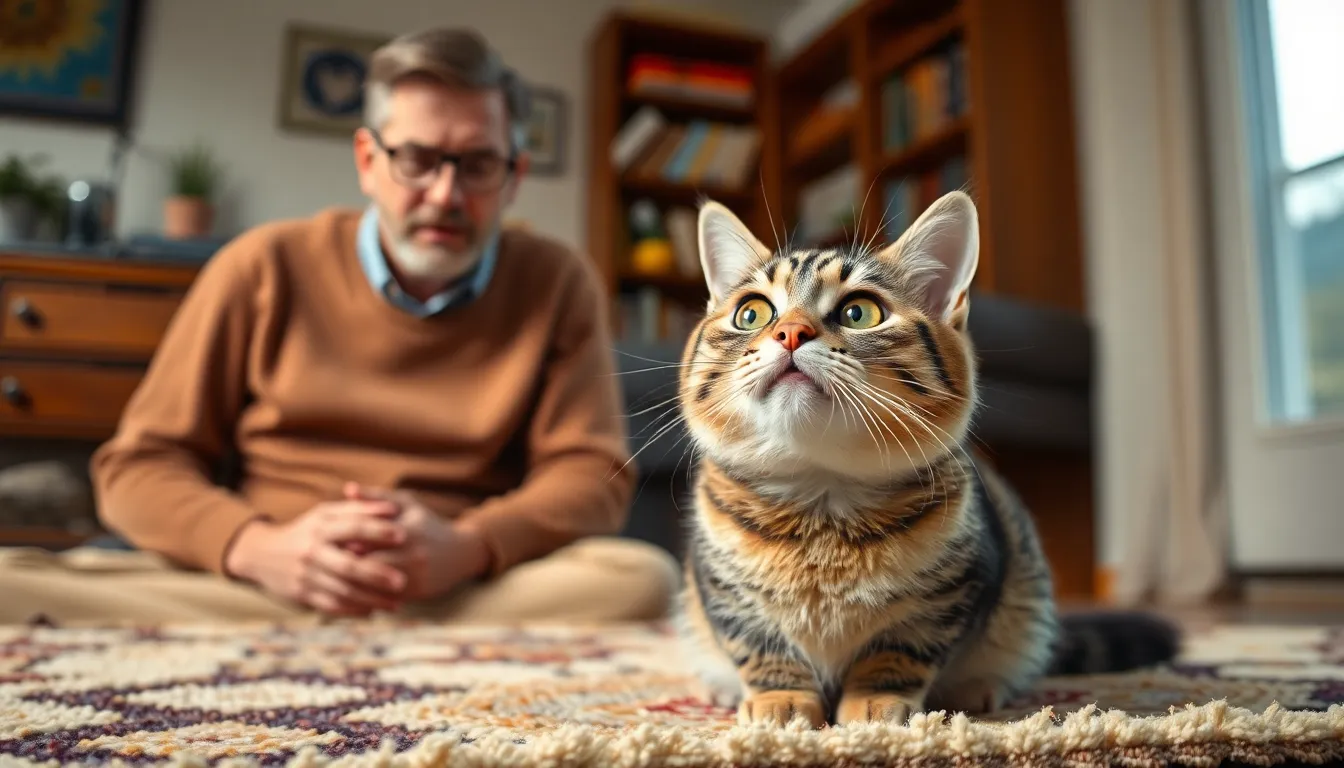Cats are quirky little creatures, and their vocalizations can leave even the most seasoned cat owners scratching their heads. From bizarre chirps to mysterious yowls, these strange sounds often raise a few eyebrows and a lot of questions. Is your feline friend trying to communicate with you or just practicing for their upcoming solo album?
Understanding why cats make weird noises can unlock a world of feline communication. It’s not just about the meows; it’s a whole symphony of sounds that can reveal their mood, needs, or even a hidden talent for opera. So if your cat’s been serenading you with its odd vocalizations, dive into the fascinating world of kitty chatter and discover what those peculiar noises really mean.
Table of Contents
ToggleUnderstanding Cat Communication
Cats use various sounds to express their emotions and needs. Understanding these vocalizations helps cat owners interpret their behavior better.
The Basics of Feline Vocalizations
Vocalizations serve as a primary means of communication for cats. These sounds vary from soft purrs to loud howls, depending on the message. Some cats are naturally more vocal than others, making the frequency and type of sound significant in assessing their mood. Kittens learn to vocalize from an early age, often mimicking their mothers. Adult cats continue using their voices to communicate with humans and other animals.
Common Sounds and Their Meanings
Different sounds carry distinct meanings. Purring often indicates comfort or contentment while hissing signals distress or threat. Chirps and trills can express excitement, particularly during playtime. Yowling and catering to mating calls show a more urgent need, often linked to breeding behavior. Meowing serves primarily as an appeal for attention, whether for food, affection, or play. Recognizing these patterns aids in understanding a cat’s emotional state.
Potential Reasons for Weird Noises

Understanding why cats make unusual sounds can reveal important insights into their well-being. Multiple factors can contribute to these vocalizations.
Health-Related Concerns
Feline vocalizations often relate to health issues. A cat making excessive noises might be dealing with pain or discomfort. Conditions like hyperthyroidism or respiratory infections can cause increased meowing or yowling. Additionally, dental problems might lead to distressing vocal sounds. If a cat suddenly changes its vocal patterns, observing for other symptoms is crucial. Unexplained weight loss, lethargy, or changes in appetite can accompany these changes, signaling a need for veterinary evaluation.
Behavioral Factors
Cats express their emotions and needs through sounds. A new environment might trigger increased vocalizations due to stress or anxiety. Social interaction also influences their noise-making; they communicate with their owners or other pets. Boredom often leads to loud meowing as cats seek attention or stimulation. Sometimes, the need for play or companionship drives a cat to vocalize more frequently. Recognizing these patterns helps owners respond appropriately to their feline companions’ needs.
Specific Noises Explained
Cats produce a range of vocalizations that offer clues about their emotions and needs. Understanding these sounds helps owners interpret their feline companions’ behaviors more effectively.
Meowing Variations
Meowing serves as a primary form of communication for cats. Owners might notice that adult cats typically use meows mainly for human interaction. Different pitches and lengths convey varying messages, with short meows often signaling a friendly greeting. In contrast, prolonged meows might express frustration or demand attention. Kittens frequently use meows to call their mothers, while older cats may modify their vocalizations as they age. Observing changes in frequency or intensity can highlight emotional states or health concerns.
Purring and Growling
Purring generally indicates contentment, often accompanied by a relaxed demeanor. Cats may purr when they feel safe or when seeking comfort from their owners. However, growling signals the opposite; it conveys distress or aggression. This sound serves as a warning to others, indicating that a cat feels threatened or annoyed. A shift from purring to growling can suggest a change in mood or discomfort, prompting owners to monitor their pet’s behavior closely. Recognizing these vocal cues can enhance the bond between cats and their humans.
When to Seek Veterinary Help
Cat owners should take immediate action if they notice sudden changes in vocalizations. Unexplained loud yowling or persistent crying signals potential health issues. Increased vocalization alongside symptoms such as weight loss, vomiting, or lethargy warrants a veterinary consultation.
Signs of distress or discomfort often manifest through unusual sounds. A cat that begins to growl or hisses when they typically don’t may experience pain or fear. Rapid vocal changes can indicate an underlying medical condition, such as hyperthyroidism or respiratory problems.
If a cat begins meowing excessively, especially at night, it might be a cry for help. This behavior may stem from anxiety or cognitive dysfunction in older cats, indicating the need for evaluation. Observing these vocal trends allows for timely intervention.
Monitoring for other signs, like changes in appetite or grooming habits, is crucial. These associated symptoms can provide additional context for the veterinarian. While occasional odd noises are normal, consistency in worrying vocal patterns should prompt further investigation.
Consulting with a veterinarian can clarify concerns regarding a cat’s health and behavior. They can help determine if a behavioral issue or a medical condition underlies the unusual noises. Addressing these changes early can improve the cat’s quality of life and strengthen the owner-pet bond.
Understanding a cat’s vocalizations is essential for any pet owner. Each sound carries meaning and can reveal much about a cat’s emotional state and needs. By paying attention to these unique noises, owners can foster a deeper connection with their feline friends.
It’s important to remain vigilant for any sudden changes in vocal patterns that might indicate health concerns. If a cat’s sounds become excessive or unusual, seeking veterinary advice is crucial. This proactive approach not only ensures the cat’s well-being but also enhances the overall relationship between the pet and its owner. Ultimately, a little insight into a cat’s communication can go a long way in nurturing a happy and healthy home.



